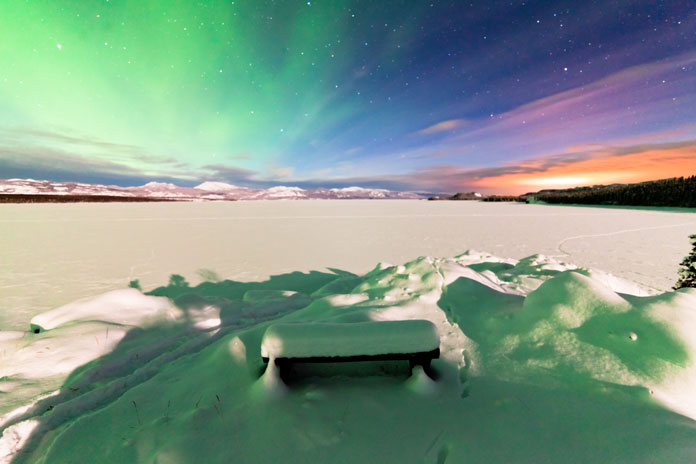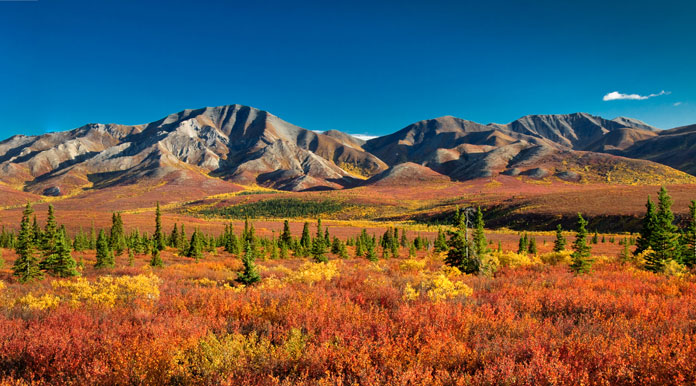The Northern Lights are also known as the aurora borealis. They are not human-made, but a natural occurrence and creation that Mother Nature has developed. There are also southern lights called Aurora Australis as well. Both derive from polar lights, called Aurora Polaris, which occur in both north and south hemispheres. The colors of the Aurora Polaris are created from particles. It starts with the sun emitting solar gas and if it manages to reach the earth, then collides with a magnetic field, creating charged particles that then float up into the atmosphere, causing the glow and the variety of colors in the northern and southern lights. They are quite beautiful and an occurrence that most of us may never see.
Table of Contents
What is the Cause of the Northern Lights Colors?
The auroras of the aurora borealis can have anything from blues and purples to warmer colors such as bright white, yellow, orange and red. No aurora is ever the same in color or pattern. There are some that are similar, but because the solar gas and the amount of the gas emitted from the sun always varies, the auroras do as well. Some displays appear more than others, like the ripping curtains display, the steady glow displays, or the pulsing displays. Some streak the sky vertically or horizontally and some create patterns there are no names for. Colors are also affected by altitude, with the color red appearing at the highest altitude, bright green in the middle and at the lowest altitude is when the blues and violets are created.

Can I see them from Anywhere?
Many people do not know that you can see the lights anywhere. Further north, the lights are on display almost every evening. Alaska, Canada, and Greenland are among the best places to see the aurora borealis and their fantastic show. The lights are shown more vividly the closer you get to either the South Pole or the North Pole. To see them look in the direction of the closest pole and hope that they work their magic and appear to you. Also, it must be dark, or no human can see them with their naked eyes.
Top Places to See the Northern Lights
The aurora borealis can be viewed from anywhere, but most people will never see them. There are some places where they are more vibrantly displayed and appear more often.

Denali National Park
Due to the lack of light pollution, Denali National Park is one of the best places to experience the northern lights. Located north of the city Anchorage, it has 2.5 million acres of wilderness, allowing hikers and campers to experience the remoteness and beauty of a vast piece of untouched wilderness. Late summer and fall are the best times to see the dancing northern lights as they appear with their lovely colors splashed across the sky.

Aroostook National Wildlife Refuge
Located across the country from Alaska, in the state of Maine, the Aroostook Wildlife Refuge has more than just wildlife to see. It lies along the U.S. and Canadian border, and there is almost no light pollution to ruin the view of the auroras. The spring and fall months are when the magnetic storm activity is strongest here, making for the perfect time to see the colorful auroras. Clear winter nights are another perfect time to finally witness some of these magical lights, as the refuge lies far enough north for the auroras to come out and play.
Idaho Panhandle National Forest
This unique setting is a northern light enthusiast favorite. Only 80 kilometers south of the Canadian border, the location is far enough north to see the lights. The winter months have many dark and bright evenings, perfect for aurora viewing. Another factor that makes this location exciting is the presence of Priest Lake within the national forest. The light reflects off the lake, proving a fantastic mirrored view of Mother Nature’s light show. This is a photographer favorite and is a spectacular scene that should not be missed.
Michigan’s Upper Peninsula
This part of the state of Michigan extends further north, into Lake Superior. The northern light viewings are common in this region, with many residents regularly seeing them, even from their own homes. The Keweenaw Peninsula or Marquette, a port on the lake, are some of the best aurora-viewing spots. Lake Superior provides the ultimate reflection of the bright color and patterned displays on clear evenings, presenting a show unlike any other.
Cook County, Minnesota
The northern part of Minnesota has tree-lined outdoor spaces amongst beautiful mountain ranges that provide an excellent backdrop for an amazing light display. Try the Oberg Mountain in the Superior National Forest to see the lights and their reflection off the mighty Lake Superior. The dark, clear skies of spring and fall give locals and visitors a glimpse at the magical colors of the auroras created in the atmosphere.
Aurora Borealis
The Northern Lights are among the most magical things in creation. Documented since the ancient times, the lights have been the subject of wonder, amazement, and legends. The atmospheric creation of such a mystical and beautiful display is something everyone needs to experience at least once in their lifetime. Gaze at the sky in wonder and appreciate one of Mother Nature’s most stunning creations. What colors and patterns might you see splashed across the northern night sky? There is only one way to find out.




Hi, I am Mason. I would like to know where exactly in Aroostook National Wildlife and Refuge can we see the Northern Light. And can I stay overnight in there to observe the scenery?
Hi Mason, maybe the website of the park is a good start to gather that information: https://www.fws.gov/refuge/Aroostook/